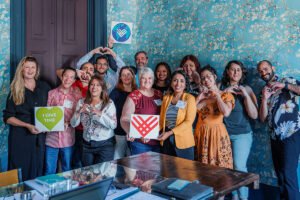This article emerges out of a lifetime of involvement in governance and reflective collaborative practice and contains simple jewels of insight about the essence of what our work can and should contain. Gus rarely slows down long enough to write so we are very grateful to him for this piece.
If we are truly concerned about the effectiveness of community-based nonprofits, a central question we must absolutely ask ourselves is whether the governance of individual community organizations enhances or interferes with good governance on a community-wide level.
I believe the behavior of individual organizations–starting at the governance level—often inhibits comprehensive community development. I come to this opinion after a lifetime in positions of public trust.
I cut my teeth in the civil rights movement. We were constantly planning while in motion, sorting out issues of goals, strategy, methodology and process. We didn’t focus on administrative systems because most of our work was done through a working cooperative and not a nonprofit organization. I am constantly reminded that we didn’t get paid for the work of social justice in those days, so we didn’t focus on sustenance, hierarchy or differences.
What guided us was a pursuit of principles, values and ethics. Our process, therefore, was inclusive, and looked to involve everyone who was affected, or necessary to achieve the best outcomes–both in planning and decisions. I developed a belief that the only way to correct immoral conditions was through moral and inclusive approaches, and this deeply informed my approach to governance.
When I was mayor of Berkeley, California, I spent time with a group of older thinkers who played major roles in the development of public policy during the 1930s. Congressman John Conyers convened this group over a number of years to think about social policy together. One member shared a report with me called “Our Cities: Their Role in the National Economy.” It was prepared for President Franklin D. Roosevelt, and laid the groundwork for the New Deal.
The New Deal was Roosevelt’s political response to the depression of the 1930s. At his request, a team of academics and social analysts surveyed each state in the union to discover programs and public policy that dealt with a multitude of social and economic ills.
One passage from this extraordinary document moved me:
“Of all our national resources–natural and man-made–the most important, and the one in terms of which all the others have to be judged, is human life. The safety, welfare and happiness of the men, women and children who compose the American people constitute the only justification of government. They are the ends for which all our resources … are merely instruments.
“The manner of life of our people, the problems they face, and the hopes and desires they cherish for improvement in their existence and the advance of their civilization should be the supreme concern of government.”
The essence of these words moved me on a spiritual, ethical and intellectual level. I realized that in order for government to function properly in the midst of change, it has to function from sound research, underwritten with sound principles and values that everyone engaged with it understands.
Nonprofits were originally created as places where people could associate with one another to pursue a common endeavor in the public interest. Currently, nonprofit work offers increased access to healthcare, childcare and jobs, and essentials from food (when we are too poor to afford it) to heating fuels, housing and job training. Our efforts in this sector regarding culture and the arts assuage the human spirit in many different ways, encourage intellectual exploration, and augment our peace of mind. For these and many other reasons, I have always believed that the nonprofit sector is the difference between chaos and a tranquil society. We make things grow in the gaps where the private sector doesn’t go and where the public sector fails miserably in both knowledge and approach.
But is there a down side to all of this saintliness? Does the net effect of so much nonprofit activity actually promote fragmentation and undermine public accountability?
In short, yes. We often address and to some extent cover up the results of inequitable public policy and bad governance at the municipal, regional, state and national levels. We do so in ways that allow interconnected issues to be dealt with too separately, and work on issues at scales that can’t possibly effect real change. And we do so in ways that disrespect the very people to whom we are most responsible.
When do we make the pursuit of policy change to promote healthy communities a primary responsibility of nonprofit governance, and what stands in our way? Laws, by the way, don’t restrict nonprofits from working actively to change policies and hold the public and corporate sectors accountable.
Without an active constituency, those of us concerned with building and maintaining healthy, vibrant communities have little chance of affecting these large forces for the better. And without networks of equally active nonprofits commonly focused on larger scale change, we are hamstrung.
At their best, nonprofits engage people in taking wise and powerful civic action. Engagement gives us credibility because if we are successful at it, we generally act in a community’s best interest. How or why have we devolved to think we can design and maintain meaningful programs without including the people that these programs are meant to benefit?
Can a doctor prescribe prescriptions to patients without examining them, or better should one? Can a lawyer defend a client without interviewing and researching the situation for which he or she is defending a client? Can a judge render a decision without hearing all of the facts?
Why do some of us serving on nonprofit boards feel that we have enough information at our fingertips without engaging those we seek to help? Isn’t it a right of our clients to assist in informing what the methods and processes should be in upgrading their quality of life?
We have a special charge. Nonprofits often provide the irritant to move stagnant or ineffective systems—it is not about helping to mollify and maintain control over marginalized communities.
Nonprofit board members should always be in a state of visioning new ways to engage constituents, because circumstances change and we must, in turn, revisit those external factors that affect people’s lives.
Responsible governance of any institution for the public good, whether public or private, should involve people in a deep dialogue about what matters to them. It should also have a serious practical side that applies a basic bottom-line analysis that periodically needs to be updated. Situations and conditions change, and strategies devised by governance bodies must change along with them.
Research is important. In public policy, for instance, one has to look at successful approaches and examples, and study the effects to real-life situations. Where have public policies made the desired difference and, when they haven’t, what were the underlying assumptions?
Public policy and social programs are too often developed simply to respond to a symptom of the moment. This may make it appear that the governance body and staff have responded. The program might indeed have a rational theory behind it. But if the theory doesn’t prove true, the problem will continue, or it will shift or become worse.
The needs of those who create the policy or run the programs may be met—in turn, they look like they have acted on the public’s concern. In fact, they are employed to do so. But in reality, they may only have prolonged the problem that the policy was supposed to fix. This practice must be looked at in relation to nonprofits that are growing operations at the same rate the communities around them are deteriorating.
Sign up for our free newsletters
Subscribe to NPQ's newsletters to have our top stories delivered directly to your inbox.
By signing up, you agree to our privacy policy and terms of use, and to receive messages from NPQ and our partners.
Governance systems have a problem when nonprofits ignore such things as the interconnections between issues, causal factors of social problems, and larger systems concerns, but instead look only within a narrow categorical purview and focus more on the institutional health of the organization than the health of the community. Nonprofit organizations–and that includes their boards–must constantly remind themselves of the purpose for which they were founded. If they do not, they are not simply acting inadequately, but are adding to the public’s sense that some social problems are intractable.
In 1988, when I became the executive director of the Dudley Street Neighborhood Initiative (DSNI) in Boston, the above point was deepened for me, illuminating what the role of a nonprofit board should be, at least under community-building circumstances.
The area served by DSNI was already served by a number of nonprofits, divided up by issue area (housing, youth work, labor and job training, multi-service centers, childcare, etc.), by ethnic group, and even by a combination of personal and organizational histories. Despite the existence of all these groups, the area was a picture of urban devastation, containing many abandoned lots full of waste, playgrounds where children would be at risk, and widespread evidence of public disinvestments in the area and its people. On first sight, all I could think was that this is the third world–in the first world—and this did not happen by chance.
Having been involved in the international political scene for a while, I looked at this simply as one more example of the colonial effect that results from apartheid-like policy approaches.
But what was most troubling in the situation was that the nonprofits, in not advocating for meaningful change through common strategies and rigor, had become party to the ongoing poor condition of the community. Where were the boards of these organizations? Were they asleep at the helm? Did they not take their responsibility seriously enough to evaluate the conditions that their nonprofit organizations were charged with correcting?
A site visit to a neighborhood nonprofit by the Mabel Louise Riley Foundation led to the idea for DSNI. Upon seeing a map of the area, one of the trustees inquired what all the dark spaces were. “Abandoned lots” was the reply.
The trustee’s response: “We come out here to award a grant to replace some worn furniture when half of the neighborhood is missing?” This good-sense approach was to continue throughout Riley’s relationship to the neighborhood.
Riley responded to the situation by providing money to a core of nonprofits serving the Dudley area. The charge under this grant was to conduct town hall-type meetings to examine the issues that most concerned residents, and to create a process to engage the community in organizing, planning, strategizing and implementation. The founders specifically decided that they didn’t want to duplicate any of the service-providing nonprofits, as they didn’t want compete with other nonprofits for common dollars.
The core neighborhood organizations suggested that nonprofits comprise 60 percent of the new board, and residents comprise 20 percent, leaving five percent each for small business representatives, community development corporations (CDC), and religious institutions, plus a compliment of local elected officials. The residents disagreed with this formation, suggesting that they should control two-thirds of the seats, and reconfigure the remaining distribution.
The residents figured that the community had been going through a state of decline despite the existence of nonprofits. As residents, they didn’t believe that these organizations should control the discussion of how their community should be rebuilt. Many of the community’s organizations understood the residents’ concerns and cooperated.
The fact that residents had such different perceptions tells us something about the disconnect between these organizations and the people they served—and tells us something about local boards’ lack of stewardship.
The working structure that DSNI adopted after the visioning, purpose and mission established an atmosphere of inclusiveness and trust among all categories and classes of players.
As DSNI got started, staff and residents went door-to-door, gathering information on what residents liked and didn’t like in their neighborhood. They were gathering data that would later prioritize steps to take, while creating depth and specificity in the demographics. Students (mainly from the Massachusetts Institute of Technology in the early days) converted the data into useful tools. These early activities helped develop working agendas with which to engage community and attract academics, private sector people with various skills and talents, and government. Such entities have the resources and capacity to complement nonprofits and residents when the situations are both challenging and structured.
These partners eventually helped realize residents’ dreams by working with them to define such details as units of housing, height limitations, open space, appropriate businesses, multipurpose centers and safety traffic standards—all to be included in a village-like atmosphere and plan that reflected the overall culture of the community.
Armed with numbers and data, DSNI hired a firm to translate the neighborhood vision into a plan that could be developed. Because of the context and the contents of this plan, DSNI was able to apply to the city for special study status, allowing the plan to establish zoning for the area. With zoning approval, DSNI was able to work under a seldom-used statute that gave nonprofits the power of eminent domain, based on defined conditions.
Armed with this designation and a thorough plan actively backed by residents, DSNI was able to attract broad pro-bono assistance. Three prestigious law firms assisted DSNI in the cost evaluation of vacant lots that DSNI hoped to acquire. Another firm assisted in the land-trust strategy and process.
In addition, a law firm filed the intent to take suit which gave DSNI the power of eminent domain. DSNI also received assistance and directions on how to apply, and get through a morass of environmental impact reports, including toxic analysis–very important to a neighborhood that had been used as a dumping site. The DSNI annual audit reflected the fact that the pro-bono work provided annually by private firms amounted to at least $1.5 million.
Because of presentations which I and others were able to make to professional groups such as the Harvard Club, of which Newell Flather (then executive director of the Mabel Louise Riley Foundation) was a member, DSNI received vital pro-bono assistance from one of the big eight accounting firms, which not only gave us a great discount on our annual audit, but developed a system to allow us to monitor any construction cost overruns. Through the Harvard Club, IBM also assisted DSNI with hardware, software and systems development.
In addition, as a result of this rigor, community and city government developed a policy to develop affordable homeownership, to stabilize the lives of the people participating in the process, and not to subject them to gentrification. The trust factor between neighborhood residents and principled professionals is another effect of this type of rigor. The community learns research, systems, new strategies, and thinking outside the box. These achievements are needed for true sustainability in community-building. To date, vacant lots have been transformed into over 440 new homes, a town common, gardens, urban agriculture, parks and playgrounds, and 500 housing units have been rehabbed. Business is growing, and rebuilding continues today.
How do we inspire such processes to wake up the sleeping giants that many community organizations have become? Our inner-city communities and other marginalized areas which nonprofits serve lose heart and hope when nonprofits function relatively aimlessly without rigor or the engagement of their constituents. This constitutes a massive failure among nonprofit governance bodies.
Here is plenty of room to rethink the role that nonprofit board members fulfill in the community. We need to take stock and recognize that many of us in our present mode are industrializing the sector. Is that what our communities need? I don’t think so. I believe the third sector should be a place of vibrancy, constantly inventing new and better ways to approach our work.
We need to create larger and more complex agendas with interlocking parts, learning from one another no matter where we are located. Our common experience base and process skills are great gifts which render us with more resources than we are aware of. As Aideen McGinley urges in her piece “Making Hope and History Rhyme: A Model for the Nonprofit Role in Active Democracy” (NPQ, Fall 2003), we need to apply our collective social capital across organizational, issue-specific and geographic borders.
And now that I’ve referenced Aideen McGinley, let’s examine the strength and approaches of international organizations. Through examination, planning and discussion, we might possibly come up with organizational hybrids to strengthen our sector. Maybe we can create loosely knit collectives through which we can blend interactive methods. With each successful venture, we should celebrate, publish, and ask others to share their stories with the network.
If ever there was a time for us to step into the national breach, it is now. Let us gather groups around the country that include recipients of services, service providers, interested professionals, policy-makers, academics, government representatives and foundation personnel, and go for the gusto. I am beginning to get goose bumps just envisioning such a process. We might begin by commissioning a number of concept papers to inform the discussion and the process. We might write the next version of “We Are The People.” I make this a call to all nonprofit board members: let’s pursue those greater heights of purpose. I look forward to the challenge, and to working with as many of you who are prepared for this venture.
Gus Newport is currently general manager of KPFA, the Berkeley-based station of the Pacifica Radio Network, following 30 years of social activism. A master community-builder who consults with development projects and foundations all over the country, his numerous roles in public life include serving as the director of the Dudley Street Neighborhood Initiative, the mayor of Berkeley, California (two terms), a member of the advisory committee of the U.S. Conference of Mayors, and vice president of the World Peace Council.








